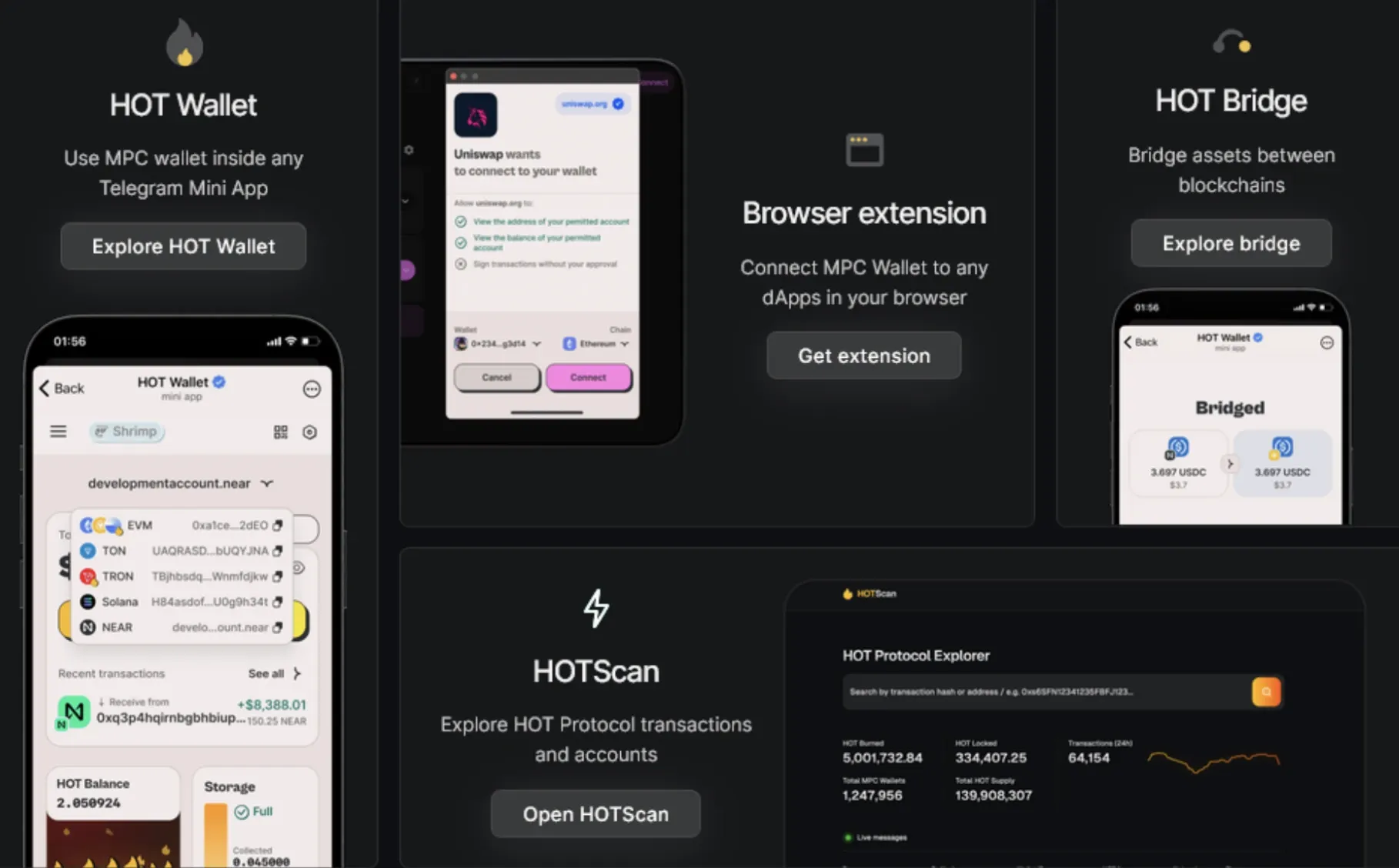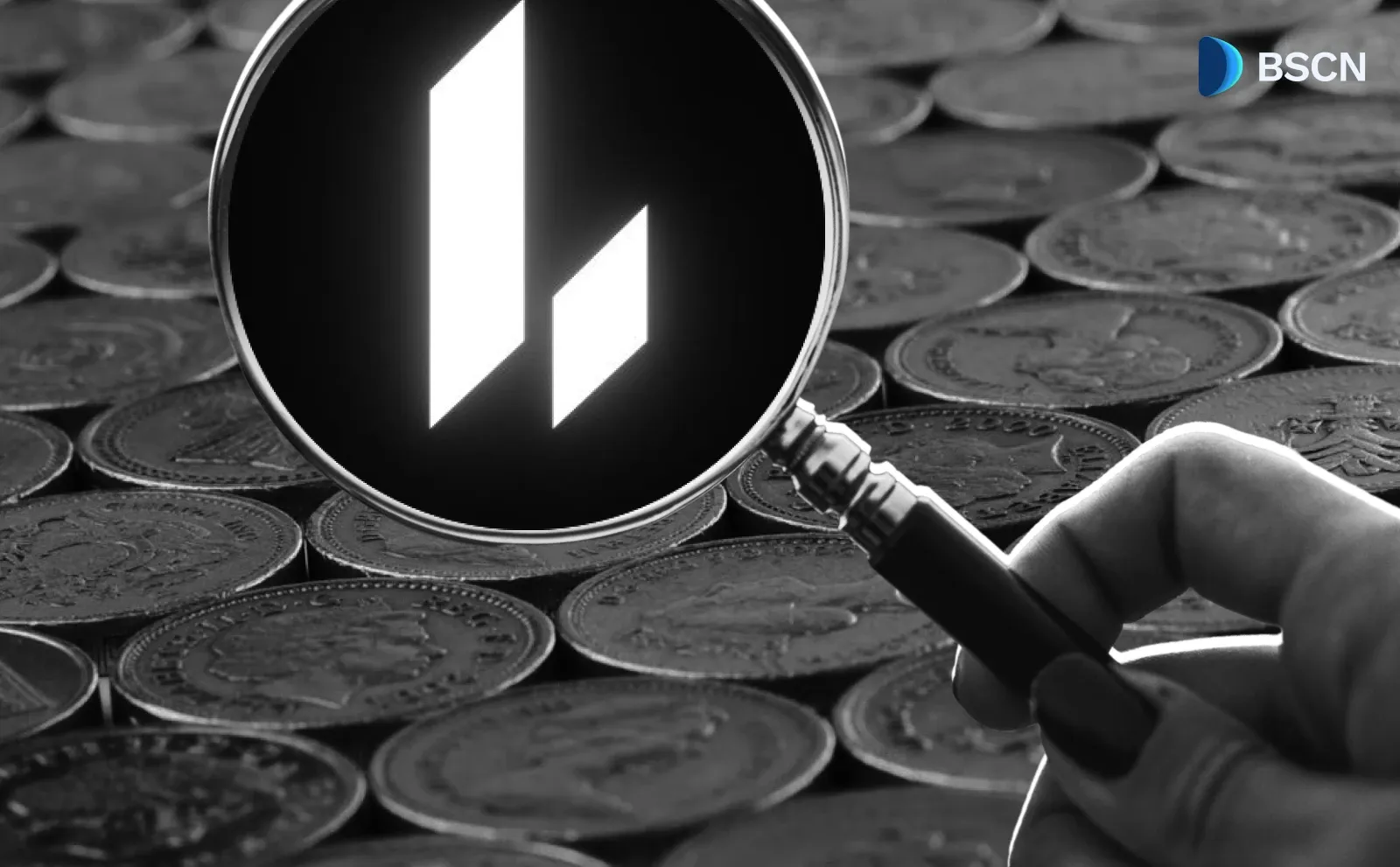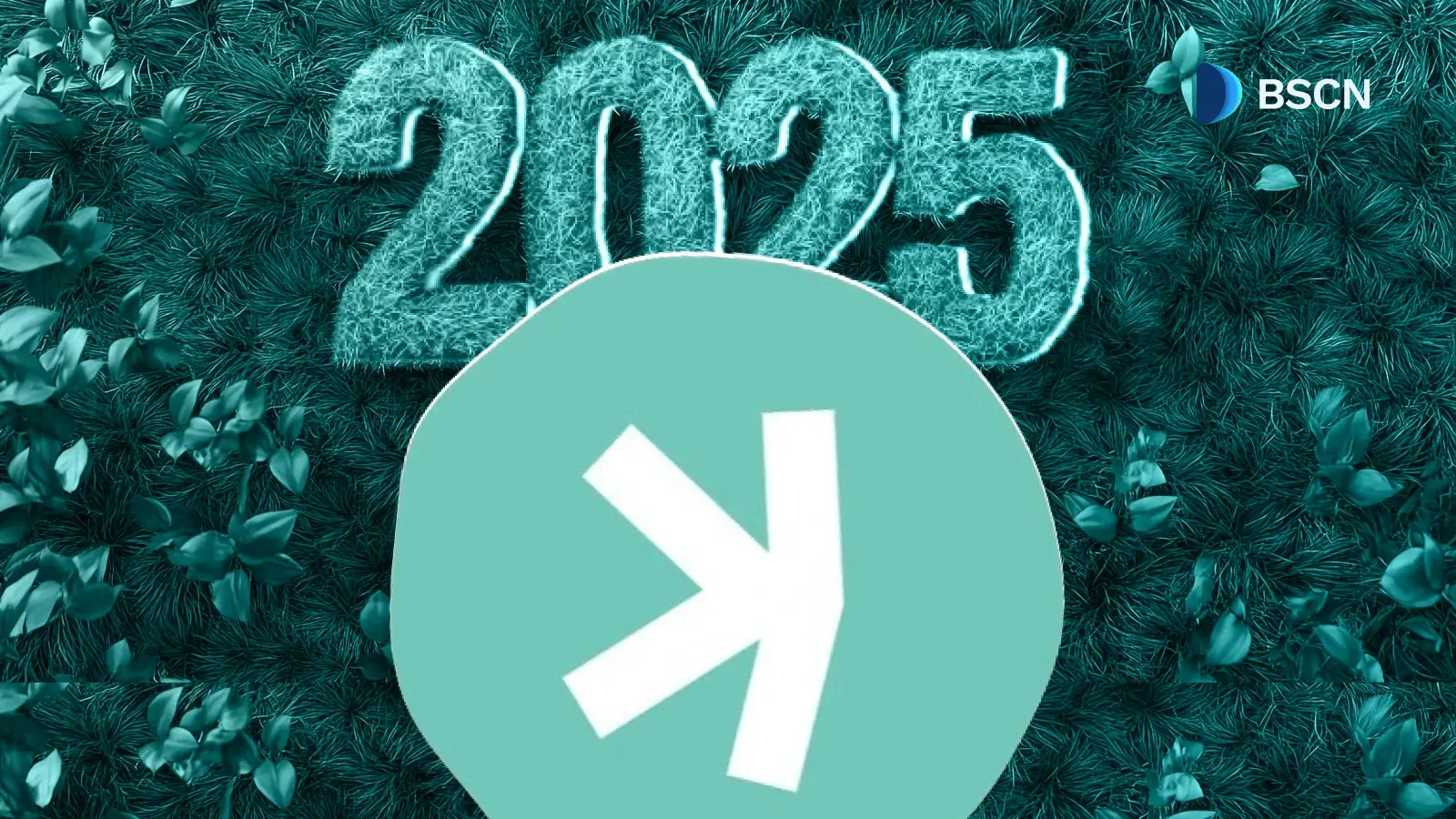Deepdive
(Advertisement)
HOT Protocol: Securing Multi-Chain Wallets for Web3 Users

HOT Protocol uses Multi-Party Computation (MPC) to create secure, user-friendly crypto wallets that work across Bitcoin, Ethereum, Solana and other chains, eliminating seed phrase risks and simplifying cross-chain transactions.
Crypto Rich
April 25, 2025
(Advertisement)
Table of Contents
The Problem with Traditional Crypto Wallets
Have you ever struggled to manage multiple crypto wallets across different blockchains? You're not alone. Millions of crypto users face this daily challenge, juggling separate seed phrases for Bitcoin, Ethereum, Solana, and other networks.
This fragmentation creates serious problems. Storing seed phrases securely often means risking loss or theft. Gas fees vary wildly between networks. Switching between wallets becomes a tedious process, and moving tokens across chains remains costly and complex.
Enter HOT Protocol – a solution built on NEAR's Chain Abstraction technology that addresses these pain points without creating yet another blockchain. Instead, HOT connects existing chains through a unified wallet experience.
What is HOT Protocol?
At its core, HOT Protocol is a decentralized Chain Signature Protocol and validator network powering advanced MPC wallets. Unlike traditional wallets that store private keys in one vulnerable location, HOT distributes keys across multiple independent validators using Multi-Party Computation (MPC).
Built on NEAR
HOT Protocol isn't trying to be the next blockchain. It's built on NEAR Protocol and uses Chain Abstraction to connect with established networks like Bitcoin, Ethereum, and EVM-compatible chains like Polygon, BNB Chain, Arbitrum, and various other non-EVM chains like Solana, TON, and many others.
Chain Abstraction is a technical approach that hides the complexities of different blockchains behind a unified interface. Rather than forcing users to understand the unique requirements of each chain, Chain Abstraction allows interactions with multiple blockchains through a single, simplified experience—similar to how we use websites without needing to understand the underlying internet protocols. This approach means HOT can focus entirely on solving wallet security and usability problems across the fragmented blockchain landscape.
The Magic of Multi-Party Computation
The secret sauce of HOT is its MPC technology, which splits private keys between trusted validators, including EverStake, NEAR Protocol, Aurora, and HOT DAO. When you initiate a transaction, the various validators collaborate to sign it – without any single one having access to your complete key. It's like having a bank vault that requires multiple keys to open, eliminating the single point of failure that plagues traditional wallets.
HOT recently expanded its capabilities by integrating the FROST MPC Protocol, bringing support for non-EVM networks such as Solana, TON, and Stellar. This integration powers features like two-factor authentication and account recovery across a broader range of blockchains.
The system's economic sustainability comes from its token model: validators stake HOT tokens to participate, while users and projects burn tokens when using the protocol. This creates balanced incentives for network security and growth.
HOT Wallet: Security Meets Simplicity
HOT Wallet brings the protocol's technology to users through an intuitive interface. Unlike many other wallets, HOT Wallet is fully non-custodial – you maintain complete control of your assets.
What makes HOT Wallet stand out is its security innovations. Imagine never again worrying about losing access to your funds, or that your seed phrase is compromised – HOT’s technology keeps your assets safe. The two-factor authentication adds an extra security layer, and there is an option that can revoke access for suspicious smart contracts that might threaten your funds.
Perhaps most impressive is HOT Wallet's seamless cross-chain experience. As of April 2025, the wallet supports over 150 networks, spanning EVM and non-EVM chains, layer-2 solutions, sidechains, and even testnets. Without manually switching networks, you can interact with assets on Ethereum, NEAR, Solana, TON, and many other chains from a single interface. This simplicity has driven remarkable adoption, with over 30 million unique wallets created – including 10 million on TON through Telegram integration and 800,000+ daily active wallets. The wallet's Chrome Extension alone has attracted over 100,000 users, reflecting its growing popularity among browser-based crypto enthusiasts.
The wallet incorporates gamified elements like HOT mining and village-based interactions, allowing users to stake tokens, earn rewards from liquidity pools, and manage assets through both the wallet interface and Telegram mini-apps.

HOT Bridge: Reimagining Cross-Chain Transfers
The frustrations of moving assets between blockchains – high fees, long waits, and security concerns – are addressed by HOT Bridge, which demonstrates the protocol's technology in action.
The bridge works through a straightforward process: a user sends tokens to a bridge smart contract on the source chain, HOT Protocol's MPC wallet verifies and signs the transaction, and the operation completes on the target chain. Unlike traditional bridges that rely on complex cross-chain messaging or third-party oracles, HOT Bridge uses the protocol's validator network for direct verification.
This approach delivers three key advantages compared to traditional bridges:
- Speed: Transactions complete almost instantly
- Lower Costs: Gas-efficient transfers reduce fees
- Security: Decentralized validator network reduces central points of failure
For users who regularly move assets between chains, these improvements can save significant time and money.
Beyond Technology: Community and Ecosystem
HOT Protocol isn't just technology – it's backed by a growing community and ecosystem. HOT DAO serves as both an innovation lab and ecological fund supporting projects across Web3, providing financial backing and community building for startups in areas like DeFi, NFTs, and distributed storage.
The protocol embraces open development with its SDK, which is available for integration into third-party projects. Developers can leverage the HOT Wallet SDK to build applications on chains like EVM chains, Solana, NEAR, and TRON, particularly within Telegram Mini Apps. This enables the creation of games and DeFi solutions where users can make transactions directly using their HOT Wallet balance, fostering seamless in-app experiences. While documentation at docs.hotdao.ai is still evolving, the project maintains an active presence with repositories on GitHub and regular community updates through X (Twitter) at @hotdao_, various Telegram groups, and you can also find them on YouTube and Instagram. With a combined number of over 10 million subscribers and followers across these platforms, the project demonstrates its popularity in the crypto space.
Balancing Innovation with Practical Challenges
While HOT Protocol introduces valuable innovations, it also faces practical challenges that are common to growing networks. Its strengths lie in programmable MPC wallets enabling security features like 2FA, chain abstraction that makes multi-chain interaction simpler, and efficient transactions through NEAR's low-fee structure.
Looking at challenges realistically, the protocol must address scaling its infrastructure to support millions of users reliably. To handle its 30 million wallets and 800,000+ daily active users, HOT is optimizing its validator network with end-to-end encrypted communication and exploring node expansion to maintain performance. Its significant reliance on Telegram for user growth creates some platform dependency risk, and developer adoption may be slowed by early-stage documentation.
The team is tackling these issues through strategic validator partnerships, ongoing protocol improvements like FROST integration, and enhanced developer resources.
The Road Ahead: Unifying the Web3 Experience
HOT Protocol aims to fundamentally improve how users interact with Web3 by making wallets more secure and easier to use across blockchain ecosystems. By removing complexity barriers, it could help bring the next billion users into crypto through enhanced security, cross-chain compatibility, and user-friendly interfaces.
The open-source SDK opens possibilities for developers to build applications like social recovery systems for lost accounts, marketplace solutions for transferable identities, and new forms of cross-chain DeFi. These developments could transform HOT from a wallet protocol into an essential Web3 infrastructure layer. HOT also actively engages its community to shape its roadmap—recently asking users which blockchains to support next, reflecting a commitment to meeting user needs as the ecosystem evolves.
As of April 2025, HOT Protocol has achieved key milestones, including launching HOT Bridge, enabling 2FA, replaceable seed phrases, and supporting over 150 networks. While validators can stake HOT tokens, the team is working on enabling full transfers, with send/receive functionality and potential exchange listings on the horizon, completing the protocol's economic vision.
Setting a New Standard for Crypto Wallets
HOT Protocol tackles longstanding cryptocurrency challenges by cleverly combining MPC security, chain abstraction, and thoughtful design. Its growing adoption – 30 million wallets and counting – demonstrates the market need for better wallet solutions.
Rather than adding another blockchain to an already fragmented ecosystem, HOT builds technology that works across existing networks. This practical approach focuses on solving real problems that users face daily: seed phrase vulnerability, cross-chain complexity, and overall security.
As cryptocurrency continues evolving across multiple blockchains, solutions like HOT that prioritize security without sacrificing usability will play a crucial role in mainstream adoption. For those interested in the future of crypto wallets, HOT Protocol represents a promising direction worth exploring today.
Ready to experience multi-chain crypto without the headaches? Visit HOT-Labs website to get started with HOT Wallet, or follow them on X @hotdao_ to stay informed on their latest news.
Read Next...
Disclaimer
Disclaimer: The views expressed in this article do not necessarily represent the views of BSCN. The information provided in this article is for educational and entertainment purposes only and should not be construed as investment advice, or advice of any kind. BSCN assumes no responsibility for any investment decisions made based on the information provided in this article. If you believe that the article should be amended, please reach out to the BSCN team by emailing [email protected].
Author
 Crypto Rich
Crypto RichRich has been researching cryptocurrency and blockchain technology for eight years and has served as a senior analyst at BSCN since its founding in 2020. He focuses on fundamental analysis of early-stage crypto projects and tokens and has published in-depth research reports on over 200 emerging protocols. Rich also writes about broader technology and scientific trends and maintains active involvement in the crypto community through X/Twitter Spaces, and leading industry events.
(Advertisement)
Latest News
(Advertisement)
Crypto Project & Token Reviews
Project & Token Reviews
Comprehensive reviews of crypto's most interesting projects and assets
Learn about the hottest projects & tokens














